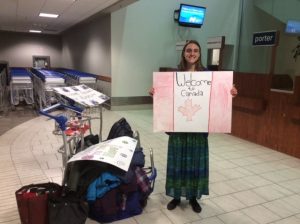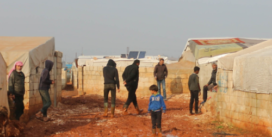- Winter Newsletter, 2025, Issue 14
- STUDENT ESSAY AND THE LIVED EXPERIENCE OF DISPLACEMENT AWARD CONTESTS
- Left out of the Levels Plan: A Call for Accessible Statistics for the Joint Assistance Sponsorship Program to Facilitate Research and Evaluation
- CARFMS2025: Canadian, Regional, and International Responses to Forced Migration
- LESSONS LEARNED FROM THE INDOCHINESE REFUGEE MOVEMENT IN CANADA IN THE 1970s AND 1980s
15 Ways to Evaluate the Success of Community Sponsorship Programs, by Rachel McNally

Last year marked 40 years since the signing of the first agreement for private sponsorship in Canada. The government credits the program for “thousands upon thousands of new Canadian success stories.”[i] But what does the government mean by “success”? How can we determine if a sponsorship program is “successful”? New research reflects on these questions, including the Refuge journal’s new Special Issue on Private Sponsorship in Canada, the forthcoming book by McGill-Queen’s University Press Strangers to Neighbours: Refugee Sponsorship in Context, and presentations at the CARFMS 2019 conference. Drawing on this research, I propose 15 ways to evaluate the success of community sponsorship programs, such as the Private Sponsorship of Refugees (PSR) and Blended Visa Office-Referred (BVOR) programs in Canada.
(Picture: Rachel McNally)
1. Durable solution
Does the program provide permanent protection and pathways to citizenship?
Sponsored refugees arrive as permanent residents and can become citizens after a few years. While durable solutions traditionally focus on permanent legal status through return or access to citizenship in a new country, Jubilut proposed that durable solutions are mechanisms to achieve “integral protection,” allowing refugees to enjoy their human rights and their rights as refugees under the 1951 Convention.[1]
2. Settlement needs
Does the program meet the concrete settlement needs of refugees?
In an evaluation of the Syrian initiative, 74.9% of PSRs (compared to 63.6% of Government-Assisted Refugees – GARs) self-reported that their immediate and essential needs were mostly or completely met soon after arrival.[2] It is concerning that not all refugees felt their needs were met.
3. Refugee perspectives
Do refugees have a positive experience in the program?
Kryiakides explained that refugees define a successful sponsorship as one that promotes their dignity and allows them to achieve their goals, including re-establishing pre-conflict social roles and forming positive relationships with sponsors.[3] The Emerging Voices Project found that refugees see benefits and drawbacks of all Canadian models: PSR, BVOR and GAR.[4]
4. Integration outcomes
Does the program lead to positive integration outcomes and equal or better outcomes compared to government programs?
A common argument in favour of community sponsorship is that it leads to better integration. There is evidence to support this argument, but it does not always take into account differences at the stage of selection, as GARs are chosen for their vulnerability while PSRs are often sponsored by family or friends in Canada. Syrian PSRs were more educated,[5] much more likely to know English or French upon arrival,[6] and were displaced for about half as long as GARs,[7] making it challenging to compare between the programs. From a government perspective, integration is usually narrowly defined in terms of economic indicators.[8] A longitudinal study showed that PSRs have higher employment rates and earnings than GARs for up to 15 years after arrival when controlling for differences in measurable characteristics.[9] The PSR employment advantage applies especially for less-educated refugees.[10] However, Lenard cautions that if sponsored refugees do not achieve financial self-sufficiency after one year, it should not be seen as a failure of the sponsorship since integration is a multi-year process.[11] In Beiser’s longitudinal study of Southeast Asian refugees, private sponsorship predicted successful resettlement (defined as refugees working, feeling healthy, and speaking English with moderate proficiency ten years after arrival) after controlling for several demographic variables.[12] Private sponsorship also builds social capital that helps access housing, employment and emotional support.[13] An evaluation of the Syrian initiative reported that 90% of both PSRs and GARs reported strong or very strong belonging to Canada.[14]
5. Resettling vulnerable refugees
Does the program resettle the most vulnerable?
Lenard argued that since there are so few resettlement spaces globally, the most vulnerable should be prioritized, and UNHCR criteria can effectively select vulnerable refugees.[15] While sponsor-referred PSRs may be vulnerable, they are not selected based on vulnerability criteria.
6. Scale
How many refugees does the program resettle?
Lenard argued that success should be measured in terms of meeting the global need for resettlement.[16] UNHCR has identified 1.4 million vulnerable refugees needing resettlement out of a broader population of over 25 million refugees needing a solution.[17] Although the PSR program aims to resettle 20,000 refugees in 2020,[18] this number is small compared to global need.
7. Additionality
Do sponsored refugees replace government resettlement?
PSR numbers in Canada remain “additional” to GAR spaces in the sense that they are separate from GAR numbers and increase Canada’s overall resettlement. However, when PSR was established, the Government of Canada committed to match the efforts of private sponsors, meaning the government would resettle an equal or higher number of refugees. Now that PSR numbers are nearly double GAR numbers (20,000 PSRs to 10,700 GARs in 2020),[19] many have expressed concerns that the government is shifting its responsibility to private sponsors. BVOR further complicates additionality through blended funding and its origins in shifting GAR spaces to BVOR spaces.[20]
8. Public opinion and welcoming communities
Does the program promote positive public opinion and encourage welcoming communities?
A major benefit of community sponsorship is that it involves residents and communities in welcoming refugees. Hynie suggests that a “central aspect of the integration process is public opinions and attitudes…which determine opportunities for inclusion and participation on the part of refugees.”[21] A recent survey revealed that 7% or an estimated two million Canadians were personally involved in sponsoring Syrian refugees, and Canadians see multiculturalism and accepting immigrants as Canada’s most positive contribution to the world.[22] There is strong public support for private sponsorship, and over 40% of Canadians see it as the most effective model for resettlement, while about half think it is equally effective as government resettlement. [23]
9. Mobilizing civil society
Does the program effectively mobilize residents and various community organizations (religious, ethno-cultural, businesses, etc.)?
Historically, the PSR program originated through the advocacy of religious groups.[24] Today, over 115 religious, community and ethno-cultural organizations have become Sponsorship Agreement Holders (SAHs).[25] At the same time, Canada’s program also limits sponsorship through proof of refugee status requirements and through restrictive caps on the number of cases SAHs can submit. The interest and capacity of potential sponsors is greater than the PSR program will allow, while the BVOR program struggles to mobilize sponsors.
10. Sustainability
Is there sufficient sponsor interest and government support to sustain the program long-term?
Private sponsorship has proven to be sustainable over 40 years, in part because of the “echo effect” that leads to sponsorships of relatives of previously resettled refugees. In contrast, the BVOR program has struggled to meet its targets given insufficient sponsor interest, both before and after the mass mobilization of the Syrian initiative.[26] As one response, the 2018 and 2019 BVOR funds emerged to cover the sponsor portion of expenses to increase the number of sponsors.
11. Effective process
Is the process clear, efficient, fair and transparent?
Procedural concerns with Canada’s sponsorship program include long processing times, a significant backlog, and sometimes high refusal rates for sponsor-referred cases. Thériault noted a lack of transparency around visa officer decisions and judicial review is typically not accessible to refugees whose applications for resettlement are rejected.[27] The existence of the Refugee Sponsorship Support Program demonstrates that the application process is so complex that volunteer lawyers are needed to assist.[28]
12. Safeguards
Are there sufficient safeguards in place to protect refugees and to hold sponsors accountable to their obligations?
SAHs are responsible for vetting, training, and monitoring the sponsors under their agreement. However, an increasing number of sponsors are Groups of 5 and Community Sponsors who are not connected to a SAH. Recently, the government established more detailed requirements for sponsorship and expanded its monitoring, but this initiative has been controversial.
13. Sponsor experience
Does the program adequately train and support sponsors, encouraging them to sponsor again?
The Refugee Sponsorship Training Program provides training to sponsors, though it is not mandatory. Sponsors also network and share resources online as they navigate new responsibilities.[29]
14. Reunifying families
Does the program reunify separated refugee families?
The PSR program has essentially become a family reunification program, but this goal is sometimes in tension with refugee protection.[30] However, considering the negative impacts of family separation on resettled refugees, a right to family unity, the importance of extended family in different cultures, PSR’s reliance on sponsor capacity, and unequal access for GARs who do not come with a sponsor, both Hyndman and Morris have questioned whether the PSR program is the most suitable pathway for refugee family reunification. [31] Instead, they suggested a separate program, similar to New Zealand’s program for refugee family reunification.
15. Global context
Does the program focus on high-profile populations at the expense of other refugees?
Bradley and Duin identified two risks of community sponsorship programs.[32] First, states may focus on resettlement and neglect other forced migrants, including asylum seekers and refugees living in the Global South. Second, sponsorship may encourage a mismatch between priorities and needs, giving resettlement spaces to high-profile groups and neglecting other refugees with protection needs. They conclude that the Canadian record is mixed.
Endnotes
[i] Immigration, Refugees and Citizenship Canada, “By the Numbers – 40 Years of Canada’s Private Sponsorship of Refugees Program,” Government of Canada, April 9, 2019, Backgrounder, https://www.canada.ca/en/immigration-refugees-citizenship/news/2019/04/by-the-numbers–40-years-of-canadas-private-sponsorship-of-refugees-program.html.
[1] Liliana Jubilut, “Durable Solutions for Refugees and Other Forced Migrants in the Global Compacts,” in Keynote (Interrogating Integration: Canadian Association for Refugee and Forced Migration Studies, York University, Toronto, Ontario, 2019).
[2] Evaluation Division, “Rapid Impact Evaluation of the Syrian Refugee Initiative” (Immigration, Refugees and Citizenship Canada, December 2016), 11, https://www.canada.ca/en/immigration-refugees-citizenship/corporate/reports-statistics/evaluations/rapid-impact-evaluation-syrian-refugee-initiative.html.
[3] Christopher Kyriakides et al., “Status Eligibilities: The Eligibility to Exist and Authority to Act in Refugee–Host Relations,” Social Forces, 2018, https://doi.org/10.1093/sf/soy109; Christopher Kyriakides et al., “Transactions of Worth in Refugee-Host Relations,” in Strangers to Neighbours: Refugee Sponsorship in Context, ed. Shauna Labman and Geoffrey Cameron (Montreal: McGill-Queen’s University Press, forthcoming 2020).
[4] Nimo Bokore, “Emerging Voices Project: Syrian Newcomers’ Perspective on Canada’s Three Sponsorship Programs,” in Panel: Private Sponsorship (Interrogating Integration: Canadian Association for Refugee and Forced Migration Studies, York University, Toronto, Ontario, 2019).
[5] Evaluation Division, “Rapid Impact Evaluation of the Syrian Refugee Initiative,” 6.
[6] Evaluation Division, 6.
[7] Michaela Hynie et al., “What Role Does Type of Sponsorship Play in Early Integration Outcomes? Syrian Refugees Resettled in Six Canadian Cities,” Refuge: Canada’s Journal on Refugees 35, no. 2 (June 5, 2019): 36–52.
[8] Luann Good Gingrich and Thea Enns, “A Reflexive View of Refugee Integration and Inclusion: A Case Study of the Mennonite Central Committee and the Private Sponsorship of Refugees Program,” Refuge: Canada’s Journal on Refugees 35, no. 2 (September 22, 2019): 14.
[9] Lisa Kaida, Feng Hou, and Max Stick, “The Long-Term Economic Integration of Resettled Refugees in Canada: A Comparison of Privately Sponsored Refugees and Government-Assisted Refugees,” Journal of Ethnic and Migration Studies June 4, 2019): 1–22, https://doi.org/10.1080/1369183X.2019.1623017.
[10] Lisa Kaida, Feng Hou, and Max Stick, “The Long-Term Economic Outcomes of Refugee Private Sponsorship,” Analytical Studies Branch Research Paper Series (Statistics Canada, January 13, 2020), https://www150.statcan.gc.ca/n1/pub/11f0019m/11f0019m2019021-eng.htm.
[11] Patti Tamara Lenard, “How Do Sponsors Think about ‘Month 13’?,” Refuge: Canada’s Journal on Refugees 35, no. 2 (June 28, 2019): 64–73.
[12] Morton Beiser, “Sponsorship and Resettlement Success,” Journal of International Migration and Integration 4, no. 2 (2003): 203–215, https://doi.org/10.1007/s12134-003-1033-z.
[13] Jill Hanley et al., “The Social Networks, Social Support and Social Capital of Syrian Refugees Privately Sponsored to Settle in Montreal: Indications for Employment and Housing During Their Early Experiences of Integration,” Canadian Ethnic Studies 50, no. 2 (August 13, 2018): 123, https://doi.org/10.1353/ces.2018.0018.
[14] Evaluation Division, “Rapid Impact Evaluation of the Syrian Refugee Initiative.”
[15] Patti Tamara Lenard, “How Should We Think about Private Sponsorship of Refugees?,” in Strangers to Neighbours: Refugee Sponsorship in Context, ed. Shauna Labman and Geoffrey Cameron (Montreal: McGill-Queen’s University Press, forthcoming 2020).
[16] Lenard.
[17] UNHCR, “UNHCR Projected Global Resettlement Needs 2019” (Geneva: UNHCR, June 2018), https://www.unhcr.org/protection/resettlement/5b28a7df4/projected-global-resettlement-needs-2019.html.
[18] Immigration, Refugees and Citizenship Canada, “Notice – Supplementary Information 2019-2021 Immigration Levels Plan,” Government of Canada, October 31, 2018, https://www.canada.ca/en/immigration-refugees-citizenship/news/notices/supplementary-immigration-levels-2019.html.
[19] Immigration, Refugees and Citizenship Canada.
[20] Shauna Labman and Madison Pearlman, “Blending, Bargaining, and Burden-Sharing: Canada’s Resettlement Programs,” Journal of International Migration and Integration, February 17, 2018, 1–11, https://doi.org/10.1007/s12134-018-0555-3.
[21] Michaela Hynie, “Refugee Integration: Research and Policy,” Peace and Conflict: Journal of Peace Psychology 24, no. 3 (August 2018): 265–76, http://dx.doi.org.proxy.library.carleton.ca/10.1037/pac0000326.
[22] “Canada’s World Survey 2018 Final Report” (Environics Institute for Survey Research, April 2018), https://www.environicsinstitute.org/docs/default-source/canada’s-world-2018-survey/canada’s-world-survey-2018—final-report.pdf?sfvrsn=17208306_2.
[23] Michael J. Donnelly, “Canadian Exceptionalism: Are We Good or Are We Lucky? A Survey of Canadian Attitudes in Comparative Perspective” (Montreal: McGill Institute for the Study of Canada and University of Toronto School of Public Policy and Governance, February 10, 2017), https://www.mcgill.ca/misc/files/misc/misc_surveyreport_0.pdf.
[24] Geoffrey Cameron, “Reluctant Partnership: A Political History of Private Sponsorship in Canada (1947-1980),” in Strangers to Neighbours: Refugee Sponsorship in Context, ed. Shauna Labman and Geoffrey Cameron (Montreal: McGill-Queen’s University Press, forthcoming 2020).
[25] Immigration, Refugees and Citizenship Canada, “Private Sponsorship of Refugees Program – Sponsorship Agreement Holders,” Government of Canada, May 14, 2019, https://www.canada.ca/en/immigration-refugees-citizenship/services/refugees/help-outside-canada/private-sponsorship-program/agreement-holders/holders-list.html.
[26] Shauna Labman and Jennifer Hyndman, “BVOR Briefing Note” (Centre for Refugee Studies, York University, May 1, 2019), https://crs.info.yorku.ca/files/2019/04/BVOR-Briefing-2019-May1.pdf.
[27] Pierre-André Thériault, “Judicial Review in Canada’s Refugee Resettlement Program,” in Strangers to Neighbours: Refugee Sponsorship in Context, ed. Shauna Labman and Geoffrey Cameron (Montreal: McGill-Queen’s University Press, forthcoming 2020).
[28] Kelsey Lange, “Mobilization of the Legal Community to Support PSR Applications through the Refugee Sponsorship Support Program,” in Strangers to Neighbours: Refugee Sponsorship in Context, ed. Shauna Labman and Geoffrey Cameron (Montreal: McGill-Queen’s University Press, forthcoming 2020).
[29] Elizabeth Coffin-Karlin, “Refugee Sponsorship in the Age of Social Media: Canada and the Syrian Refugee Program,” in Strangers to Neighbours: Refugee Sponsorship in Context, ed. Shauna Labman and Geoffrey Cameron (Montreal: McGill-Queen’s University Press, forthcoming 2020).
[30] Sabine Lehr and Brian Dyck, “‘Naming’ Refugees in the Canadian Private Sponsorship of Refugees Program: Diverse Intentions and Consequences,” in Strangers to Neighbours: Refugee Sponsorship in Context, ed. Shauna Labman and Geoffrey Cameron (Montreal: McGill-Queen’s University Press, forthcoming 2020).
[31] Stephanie Morris and Patti Tamara Lenard, “Building Resilience: Family Reunification and Refugee Resettlement in Canada,” in Panel: Children, Youth & Families (Interrogating Integration: Canadian Association for Refugee and Forced Migration Studies, York University, Toronto, Ontario, 2019); Jennifer Hyndman, “The Practical Politics of Both/And Private Sponsorship: Why BVORs Cannot Replace PSRs,” in Panel: Private Sponsorship (Interrogating Integration: Canadian Association for Refugee and Forced Migration Studies, York University, Toronto, Ontario, 2019).
[32] Megan Bradley and Cate Duin, “A Port in the Storm: Private Refugee Sponsorship in the Context of the International Refugee Regime and Canadian Forced Migration Policy,” in Strangers to Neighbours: Refugee Sponsorship in Context, ed. Shauna Labman and Geoffrey Cameron (Montreal: McGill-Queen’s University Press, forthcoming 2020).
 Rachel McNally is a Master’s in Political Science student at Carleton University in Ottawa. She researches refugee resettlement policy in Canada and her past research focused on refugee sponsorship in rural Nova Scotia. Rachel has also been involved with refugee issues as a sponsor, an intern with UNHCR Ottawa, and a Project Officer with the Local Engagement Refugee Research Network.
Rachel McNally is a Master’s in Political Science student at Carleton University in Ottawa. She researches refugee resettlement policy in Canada and her past research focused on refugee sponsorship in rural Nova Scotia. Rachel has also been involved with refugee issues as a sponsor, an intern with UNHCR Ottawa, and a Project Officer with the Local Engagement Refugee Research Network.

